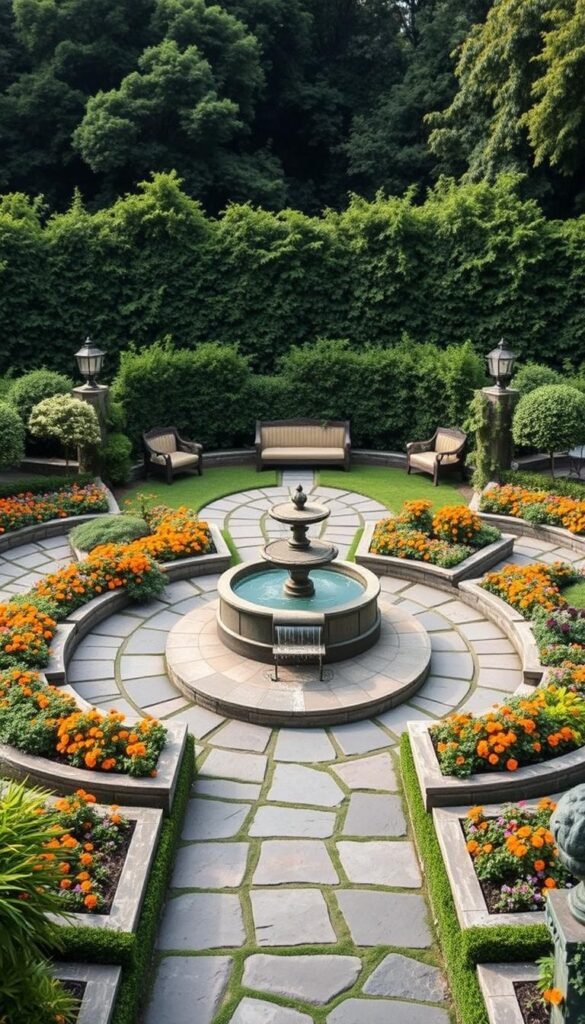What if your outdoor space could feel more welcoming without major renovations? Rounded layouts have a hidden power to create harmony, blending nature’s curves with human comfort. Studies show circular patterns subconsciously make us feel at ease—like gathering around a campfire or walking a winding forest path.
Many yards stick to straight edges and sharp corners, but these shapes can feel rigid. Softening angles with flowing lines helps energy move freely, turning a basic lawn into a relaxing retreat. This approach isn’t just pretty—it taps into design philosophies that value balance and connection.
You’ll learn how simple tweaks, like curved flower beds or rounded seating areas, invite calmness. These ideas work for small patios or sprawling landscapes, proving creativity thrives when you break away from rectangles. Let’s explore how to craft a space that feels uniquely yours while celebrating nature’s organic beauty.
Circular Garden Design Concepts: Embracing Unique Shapes for a Distinct Look
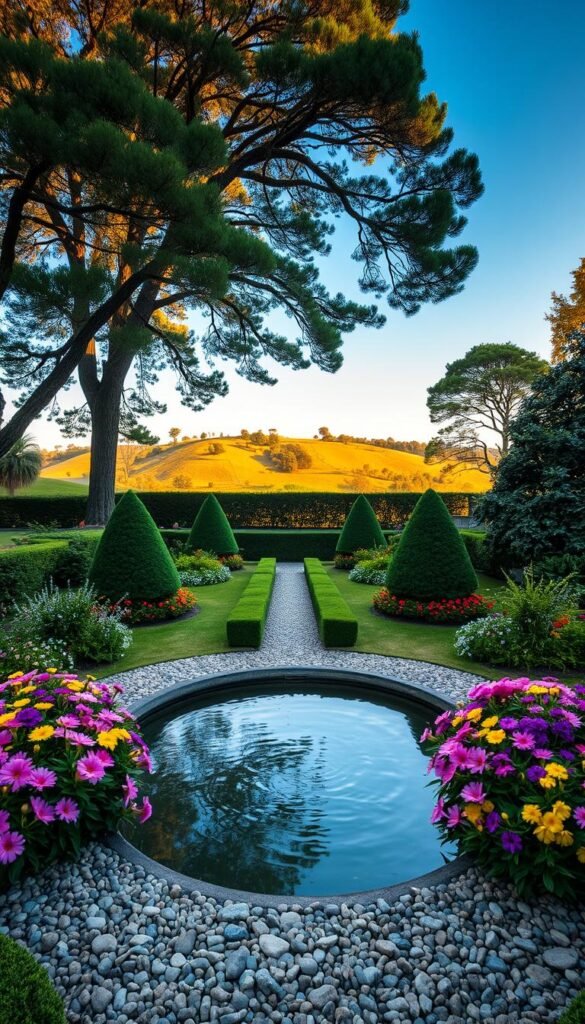
Imagine stepping into a backyard that naturally draws people together. Rounded patterns do more than look pretty—they influence how energy flows and emotions settle. Research reveals curved layouts subconsciously signal safety, much like protective enclosures found in nature.
Traditional square beds often create static zones, while curves encourage movement and connection. Feng Shui principles highlight how rounded forms symbolize unity, reflecting the infinite cycle of growth. “A circle holds no corners for energy to stagnate,” one expert notes, emphasizing their role in balanced outdoor areas.
You’ll notice professionals blending these organic lines into modern landscapes. Curved seating nooks or winding planters guide visitors effortlessly through the space. This approach works wonders for creative gardening ideas, turning awkward corners into cozy conversation spots.
Three key benefits make rounded layouts stand out:
- Flow: Soft edges prevent harsh visual breaks
- Focus: Central features become natural gathering points
- Flexibility: Curves adapt to uneven terrain better than rigid angles
By embracing these principles, your yard gains rhythm without sacrificing functionality. It’s about creating places where people linger—not just pass through.
Unleashing Creativity in Transforming Odd-Shaped Gardens
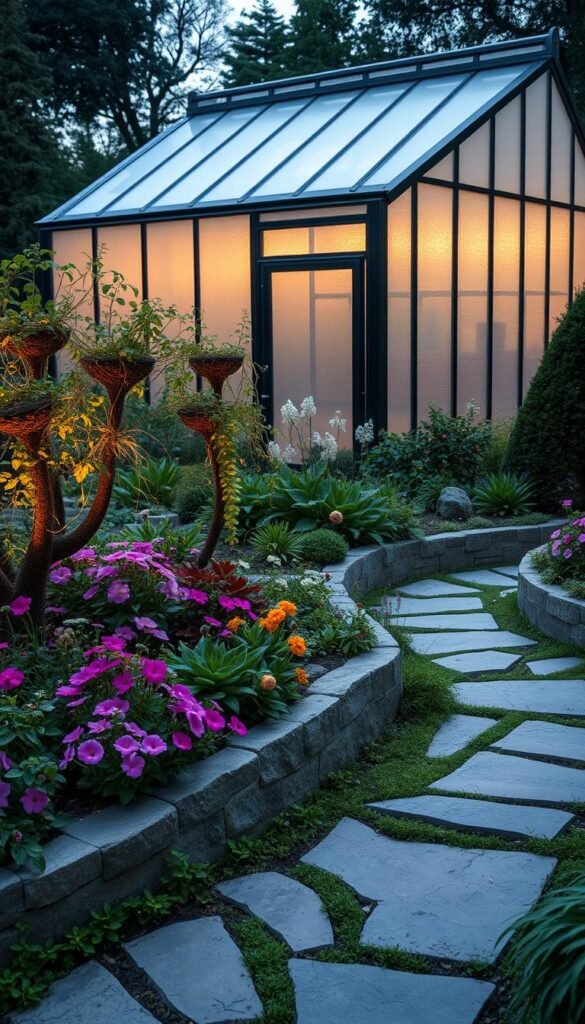
Struggling with awkward corners or narrow areas? These “problem spots” hold untapped potential. Instead of hiding them, use clever ideas to turn quirks into standout features. The key lies in directing attention and making every inch work for you.
Identifying Focal Points and Unique Corners
Start by spotting natural attention-grabbers. A mature tree or vintage bench can become your garden’s star. Place bold elements like stone sculptures or bubbling fountains where angles converge—they’ll distract from tight spaces while adding personality.
Try this trick: position seating areas diagonally across sharp corners. This softens edges and creates cozy nooks. Even slim strips between fences can host vertical herb gardens or climbing roses.
Maximizing Functionality in Unconventional Spaces
Multi-level solutions work wonders in cramped areas. Tiered planters add depth, while hanging baskets free up ground space. For L-shaped yards, define zones with different textures—pebble pathways here, moss gardens there.
| Challenge | Solution | Impact |
|---|---|---|
| Narrow side yard | Curved stepping stones | Creates walking flow |
| Triangular corner | Corner water feature | Masks sharp angles |
| Uneven ground | Raised vegetable beds | Adds usable surface |
Don’t forget vertical surfaces! Trellises with flowering vines draw eyes upward, making small yards feel spacious. For a rustic touch, try repurposing old items as planters—metal buckets or wooden crates add charm while solving space issues.
Design Ideas for Triangular, L-Shaped, and Narrow Gardens
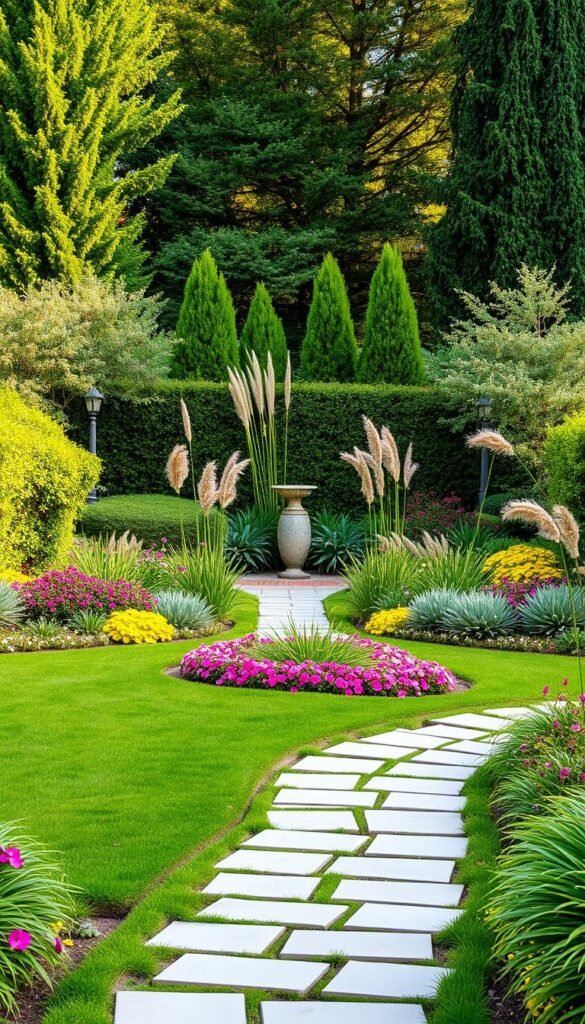
Odd-shaped yards don’t need to limit your creativity—they can spark it. With smart design ideas, even the most challenging layouts become opportunities to craft something memorable. Let’s dive into solutions that turn geometric quirks into functional beauty.
Tips for Triangular Gardens
That awkward corner? It’s prime real estate. Tuck a small bistro set or built-in bench there to create a cozy vantage point. Surround it with vertical planters filled with ivy or climbing hydrangea—their cascading leaves soften sharp angles naturally.
For balance, position taller shrubs or ornamental grasses along the triangle’s longest side. This tricks the eye into seeing symmetry. Add a sun-loving herb spiral in the center for both visual interest and fresh flavors.
Innovative L-Shaped Layouts
Use the bend in an L-shaped garden to your advantage. Create distinct zones: a dining area in one arm and a fire pit lounge in the other. Connect them with curved gravel paths bordered by lavender or dwarf boxwoods.
Break up straight lines with winding flower beds. Try alternating paving stones with ground cover plants like creeping thyme. For elevating your space, install tiered plant stands along walls—they add depth without crowding narrow areas.
Three quick wins for tricky plots:
- Mirror panels on fences to visually double your space
- Potted citrus trees in corners to fill vertical gaps
- Curved retaining walls that guide foot traffic
Inspiring Curved Garden Elements and Organic Pathways
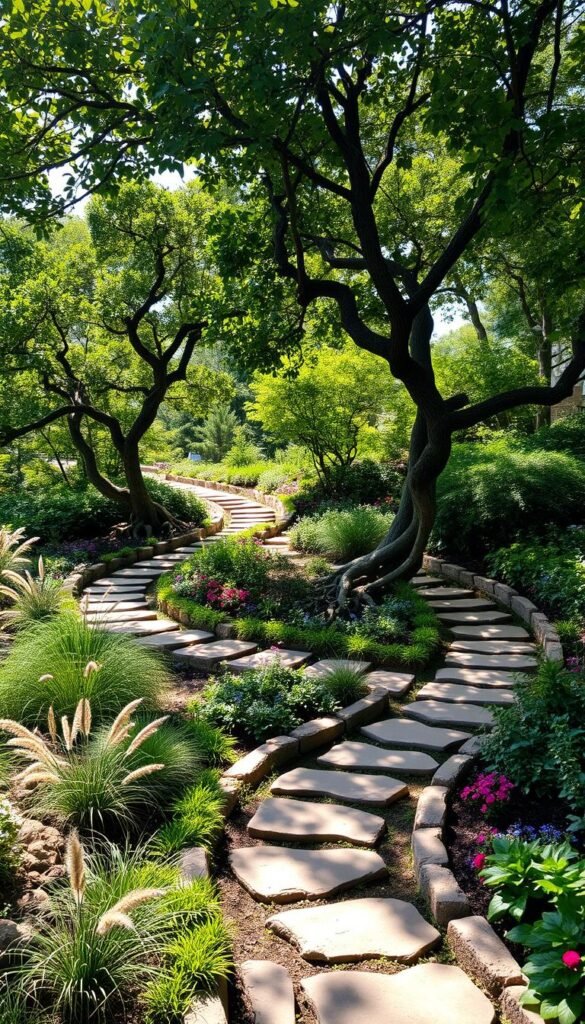
Curves in your landscape do more than please the eye—they shape experiences. Unlike straight lines that rush you forward, winding pathways invite pause and discovery. This approach mirrors how nature designs forests and riverbanks, where nothing grows in perfect rows.
Embracing Natural Curves
Soft, flowing borders let your garden breathe. Instead of rigid edges, try using irregular stones or low-growing thyme to outline beds. These elements create gentle transitions between lawn areas and planting zones, reducing maintenance while boosting visual appeal.
Materials matter when crafting organic shapes. Flagstone fragments arranged like puzzle pieces or decomposed granite packed between logs achieve that “found in the wild” look. One landscaper notes: “Curved edges feel intentional yet effortless—they’re the secret sauce of timeless yards.”
Benefits of Winding Pathways
A meandering path does double duty. It slows foot traffic, encouraging visitors to notice your favorite plants. In compact spaces, clever curves create illusions of depth—you can’t see the end from the start, making yards feel larger.
Parents love how these routes spark kids’ curiosity. Hide a birdbath or miniature fairy door around bends for surprise moments. Even basic materials like bark mulch gain charm when laid in swooping patterns rather than straight lines.
Vertical Gardens and Layered Planting Techniques
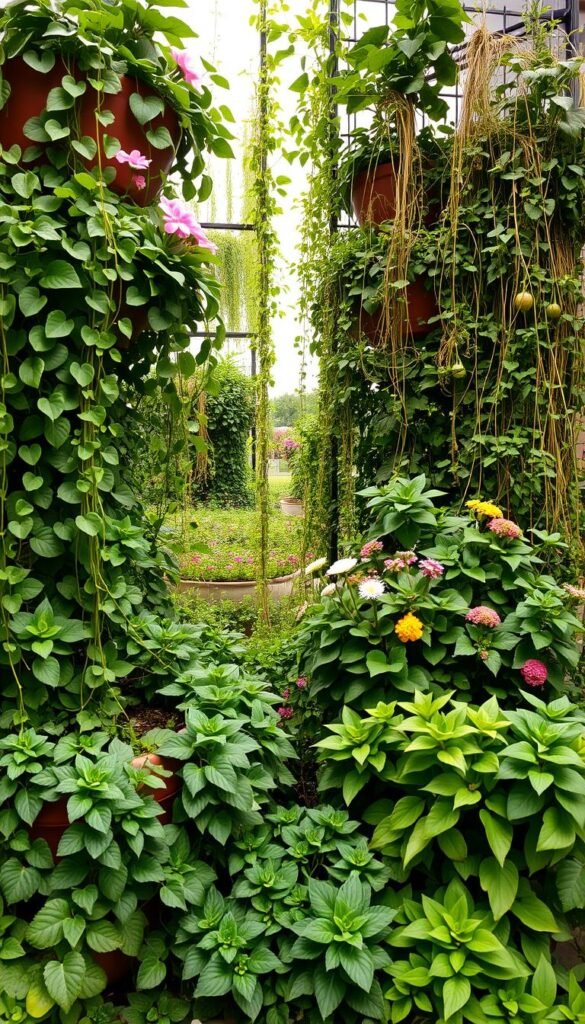
Looking up could be the secret to expanding your garden’s potential. Vertical solutions turn blank walls and narrow areas into thriving green zones. Even better? They create instant depth in small yards through smart layering.
Creative Vertical Solutions
Start with climbing plants like clematis or jasmine on trellises. These natural curtains soften hard surfaces while saving ground space. For edible options, try snap peas or pole beans—they’ll reward you with snacks and shade.
Raised beds with tiered shelves work wonders for herbs and succulents. Place taller specimens like dwarf fruit trees at the back, then layer downward with flowering annuals. This approach mimics nature’s stacking while keeping everything within reach.
| Vertical Solution | Best Plants | Space Saved |
|---|---|---|
| Wall-mounted planters | Strawberries, trailing lobelia | 85% floor area |
| Freestanding pergola | Wisteria, climbing roses | Creates shaded seating |
| Hanging gutter system | Lettuce, mint, pansies | 100% ground space |
Urban gardeners love how vertical systems transform tight spots. As one grower notes: “My fire escape became a salad bar using hanging pockets and upward-trained tomatoes.” Pair these ideas with container gardening ideas for urban balconies to maximize every inch.
Three layering rules for success:
- Place bold textures (like elephant ears) at mid-level
- Use ferns or ivy to fill gaps between structures
- Rotate pots seasonally for year-round color
With these techniques, your garden gains height and character. It’s about working smarter—not harder—to create lush, inviting spaces.
Incorporating Water Features and Paving Solutions
Water’s gentle murmur can turn any yard into a retreat. A small pond with curved edges becomes both visual art and nature’s soundtrack. Pair it with submerged pumps for soft ripples—this aeration keeps water fresh while attracting dragonflies and birds.
Your patio deserves the same attention as your plants. Choose materials that mirror your style—rustic flagstone for cottage vibes or sleek concrete slabs for modern spaces. Mix cream and charcoal stones to add depth without overwhelming the eye.
Selecting the Ideal Outdoor Pavers
Durable options balance beauty and function. Consider foot traffic and climate when picking surfaces. Textured pavers prevent slips after rain, while smooth varieties suit dining areas.
| Material | Best For | Maintenance |
|---|---|---|
| Natural stone | Rustic pathways | Seal annually |
| Porcelain | Modern patios | Wipe clean |
| Gravel | Budget-friendly zones | Rake monthly |
Coordinate hardscaping with plant colors—orange marigolds pop against slate-gray landscaping rocks. One homeowner shares: “Our bubbler fountain makes the space feel alive, even when we’re inside.” These touches elevate ordinary yards into polished extensions of your home.
Choosing a Color Palette and Material Combinations
Have you ever noticed how some outdoor spaces just feel put-together? The secret often lies in intentional color coordination. Like matching jewelry to an outfit, your garden thrives when materials and hues work in harmony.
Start by picking a base palette of 3-4 colors. Warm terracotta pots paired with silver-gray pavers create earthy calm, while cobalt blue accents pop against white fences. Stick to these tones across plants, furniture, and hardscaping for a polished look that ties your landscape together.
Cohesive Aesthetic Choices for Your Garden
Lighter shades work magic in tight spaces. Pale gray decking reflects sunlight, making narrow patios feel airy. Match it with lavender or soft yellow blooms for a cheerful yet unified vibe. Darker tones? Save them for statement pieces like charcoal fire pits or espresso-stained benches.
| Material | Color Palette | Best Use |
|---|---|---|
| Natural wood | Earthy browns + sage | Rustic themes |
| Powder-coated metal | Slate + cream | Modern homes |
| Recycled composite | Driftwood gray + seafoam | Coastal yards |
Need inspiration? Browse proven color schemes that adapt to any size or style. Remember: repetition creates rhythm. Echo flower colors in cushion fabrics or ceramic planters for that “designed by a pro” feel.
Three quick tips for success:
- Sample materials in different daylight conditions
- Use evergreens as neutral backdrops
- Limit metallic finishes to two types max
When every element sings the same color tune, your outdoor area becomes a visual retreat that flows seamlessly from zone to zone.
Breaking Up Space with Defined Zones and Outdoor Rooms
Transform your yard into a series of inviting destinations without expanding its footprint. Strategic zoning turns sprawling lawns or cramped patios into purposeful spaces that feel both organized and inviting. Think of it as interior design for your outdoor space—each “room” serves a unique role while contributing to the whole.
Crafting Multi-Functional Garden Areas
Start by mapping activities you love. Want morning coffee spots and sunset dining? Divide your area using these simple dividers:
- Low hedges of boxwood or lavender
- Decorative screens with climbing vines
- Raised beds doubling as seat walls
An L-shaped layout naturally separates zones. Use the longer arm for vegetable plots and the shorter bend for a hammock retreat. One homeowner shares: “Our fire pit zone stays separate from the kids’ play space, yet everything flows together through repeating stone textures.”
| Zone Type | Defining Element | Purpose |
|---|---|---|
| Dining | Pergola with string lights | Evening gatherings |
| Reading | Weatherproof daybed | Quiet relaxation |
| Growing | Vertical planters | Fresh herbs/salads |
Connect zones with meandering paths using mismatched pavers or aromatic thyme. This landscaping trick guides movement while letting each space keep its identity. For tight spaces, foldable furniture or rolling planters let you switch functions daily—breakfast nook by dawn, cocktail corner at dusk.
Striking a Balance: Linear Edges Versus Natural Curves
Have you ever noticed how the best gardens feel both wild and organized? Strategic straight lines give structure to flowing designs, like a frame around a painting. Landscape designer Scott Zimmer proves this with his crisp metal edging between lawns and pathways—it keeps grass in check while adding polished contrast.
Integrating Geometric Borders
Sharp edges work best when they serve a purpose. Try stone borders around curved flower beds or composite timbers defining seating areas. These elements prevent mulch from spilling onto walkways while creating clean visual breaks. As Zimmer notes: “Precision doesn’t fight nature—it highlights its beauty.”
Popular edging materials offer different benefits:
- Powder-coated aluminum: Sleek modern lines that resist rust
- Recycled brick: Warmth that ages gracefully
- Concrete pavers: Custom shapes for organic curves
In your landscaping, place straight edges where function matters most—along high-traffic paths or between distinct zones. Let plants spill over slightly to maintain that effortless feel. This approach keeps maintenance low while making your garden look professionally planned.
The Power of Circular Elements in Garden Atmosphere
Why do we instinctively gather around campfires or flock to crescent-shaped beaches? Our brains are wired to find comfort in rounded forms. This primal connection explains why circular features in outdoor spaces feel inherently welcoming—they mirror nature’s most reassuring patterns.
Psychological and Feng Shui Benefits
Studies show people perceive circles as safer than angular shapes. This isn’t just modern psychology—ancient Feng Shui principles link rounded forms to celestial energy flow. “A circle represents infinite potential,” notes designer Lila Chen. “It nurtures life by preventing energy from getting trapped in corners.”
Three key advantages emerge when using these shapes:
- Social Magnetism: Circular seating areas naturally draw people together
- Stress Reduction: Soft edges lower cortisol levels by 12% compared to sharp angles (University of Oregon study)
- Seasonal Adaptability: Curved beds allow better sun exposure for plants
Encouraging Positive Energy with Curves
Incorporate arcs through winding stone paths or oval water features. These elements guide movement while maintaining visual harmony. Even small touches matter—try hanging rounded wind chimes or positioning potted plants in spiral formations.
| Element | Psychological Impact | Feng Shui Benefit |
|---|---|---|
| Round fire pit | Encourages conversation | Activates social energy |
| Circular pond | Promotes relaxation | Enhances wealth flow |
| Arched trellis | Creates safe passage | Connects earth and sky |
By blending these concepts, your space becomes a sanctuary that feels both timeless and alive. It’s not about rigid rules—it’s creating environments where every curve whispers, “Stay awhile.”
Creative Circular Garden Features: Mandalas, Ponds, and More
Ancient symbols hold surprising power in modern landscapes. The mandala’s timeless patterns—rooted in spiritual traditions—offer fresh ways to organize planting beds and water elements. These features transform ordinary yards into spaces that calm the mind while maximizing functionality.
Designing with Mandalas and Circular Beds
Mandalas work like nature’s blueprints. Arrange herbs or flowers in concentric circles around a central statue or birdbath. Keyhole beds take this further—their curved notch lets you reach every plant without stepping on soil. Perfect for compact spaces, they boost yields while keeping your garden tidy.
Enhancing Focal Points with Circular Ponds
Water features shaped like circles become instant gathering spots. Position one where sunlight dances on its surface, or add floating lotus for serene vibes. Surround it with smooth stones and moisture-loving ferns to blur the line between crafted and wild.
These ideas prove that purposeful shapes do more than decorate—they create moments of pause. Your garden becomes a living meditation tool, inviting you to slow down and savor its evolving beauty.

